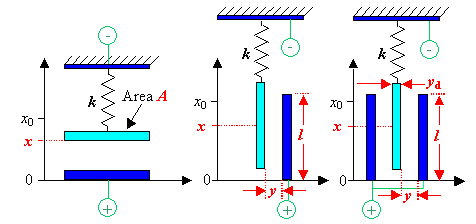 |
Let's look at the three different situations where we can produce forces electrostatically
by using capacitive structures |
|
 |
We consider one fixed plate with either a given area A or a dimension h
· l (h would be the height in the z-direction in the drawing below), and a moveable
plate of identical dimension to keep things easy. We also have a spring with a spring konstant k to keep the
moveable plate in force equilibrium. The position xo is the equilibrium position for zero voltage.
The terminals show schematically how voltage would be applied. |
|
|
|
|
 |
We consider only movements in the x-direction as shown
for the three configurations given (where the plates have moved some distance x from their equilibrium position
(zero voltage at x = 0). |
|
 |
The third configuration embodies one element of a comb
structure that we have encountered a few times already. We assume that there is a potential differenceU
between the plates of the capacitors. |
| |
|
 |
Here are the questions: |
|
 |
1. Find the proper relations for the forces pulling at the moveable plates for all three configurations. |
|
 |
2. Compare the relative strength of the first and third configuration (you may assume that y
» yd) |
|
 |
3. Discuss the pros and cons of the two configurations for driving an actual actuator. |
| | |
 |
Hint: Consider the work W = E
needed to move a plate and remember that Force F = –dW/dx |
| | |
© H. Föll (Semiconductor Technology - Script)

![]() 7.1.3 MEMS Sensors and Actuators
7.1.3 MEMS Sensors and Actuators ![]() Solution to Exercise 7.1-2 Forces in Capacitive Structures
Solution to Exercise 7.1-2 Forces in Capacitive Structures